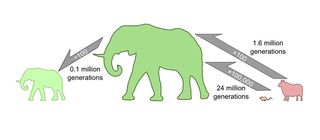Evolution Shrinks Mammals Quickly, But They're Slow to Grow

Within as little as 24 million generations, mammals can evolve from the size of a mouse to the size of an elephant, a new study estimates.
This calculation is based on the most rapid increase in size seen in the fossil record after a mass extinction wiped out their much larger competitors, the dinosaurs. They also found animals can shrink more than 10 times as fast as they can grow to giant sizes.
"What we wanted to know is how quickly could they evolve from these tiny, scampering mammals to the behemoths of the land we see now," Alistair Evans, the lead study researcher and an evolutionary biologist at Monash University in Australia wrote in an email to LiveScience. "It's a classic story of taking advantage of a new opportunity — the vacant landscape devoid of dinosaurs."
At the end of the Cretaceous Period, about the time the dinosaurs disappeared, mammals were small — the largest ones appear to have been rodent-like creatures about the size of rabbits, weighing about 6.6 lbs. (3 kilograms).
Within about 40 million years, the largest land mammal ever to live had emerged: the Indricotherium.
Related to horses and rhinos, the tusked, tree-leaf-eating Indricotherium is estimated to have weighed as much as 33,000 lbs. (15,000 kg), according Evans.
Evans and his colleagues looked at size changes within 28 groups of mammals, called orders of mammals, on four continents and all ocean basins. They found a discrepancy between the rate of change within species and the rate of change within higher level groups that include many species, such as orders. Within species, change happens more quickly, but these rates do not last for long.
Sign up for the Live Science daily newsletter now
Get the world’s most fascinating discoveries delivered straight to your inbox.
If they did, the team calculates that mammals could go from mouse-size to elephant-size in 200,000 generations. However, the fossil record demonstrates large-scale changes don't happen this quickly, according to Evans.
While mammals got steadily bigger after the dinosaurs disappeared, the rates at which they did so varied among the groups.
The fastest group was the cetaceans, or aquatic mammals, such as whales and dolphins, which became bigger at about twice the rate of land-dwelling mammals. Cetaceans' ancestors were originally land-dwelling, and the switch to water most likely encouraged them to grow rapidly, since they no longer needed to support their own weight and because large size helps prevent the loss of body heat in water, according to Evans.
The largest primate — the group to which humans belong — was Gigantopithecus blacki, an extinct ape that weighed about 1,100 lbs. (500 kg). As impressive as that might look, primates showed the slowest rate of size increase of any group; Evans is not sure what's behind the slow rate.
"There seems to be some intrinsic maximum rate that each order evolves at, which may have something to do with the basic construction or physiology of each group," he wrote. "So it may be really hard to be built like a primate and get very big."
Things can get smaller much faster than they can get big, they also found. Mammals can shrink at more than 10 times the rate at which they get bigger, and among animals living in isolated environments, primarily on islands, the decrease in size can be even more rapid.
For example, dwarf elephants that once inhabited islands in the Mediterranean Sea weighed about 220 lbs. (100 kg). They are believed to be descended from larger European elephants, weighing 100 times as much, which lived on mainland Europe. This decrease happened in less than 800,000 years, much faster than any rate of increase over the last 70 million years, Evans said.
The research was published Monday (Jan. 30) in the journal Proceedings of the National Academy of Sciences.
Editor's Note: This article was corrected on Monday, Jan. 30 at 5:38 p.m. Eastern Standard Time. The earlier version incorrectly identified the Indricotherium as the largest mammal ever to live. The largest mammal is the blue whale. The Indricotherium, which is now extinct, was the largest land mammal.
You can follow LiveScience senior writer Wynne Parry on Twitter @Wynne_Parry. Follow LiveScience for the latest in science news and discoveries on Twitter @livescience and on Facebook.

